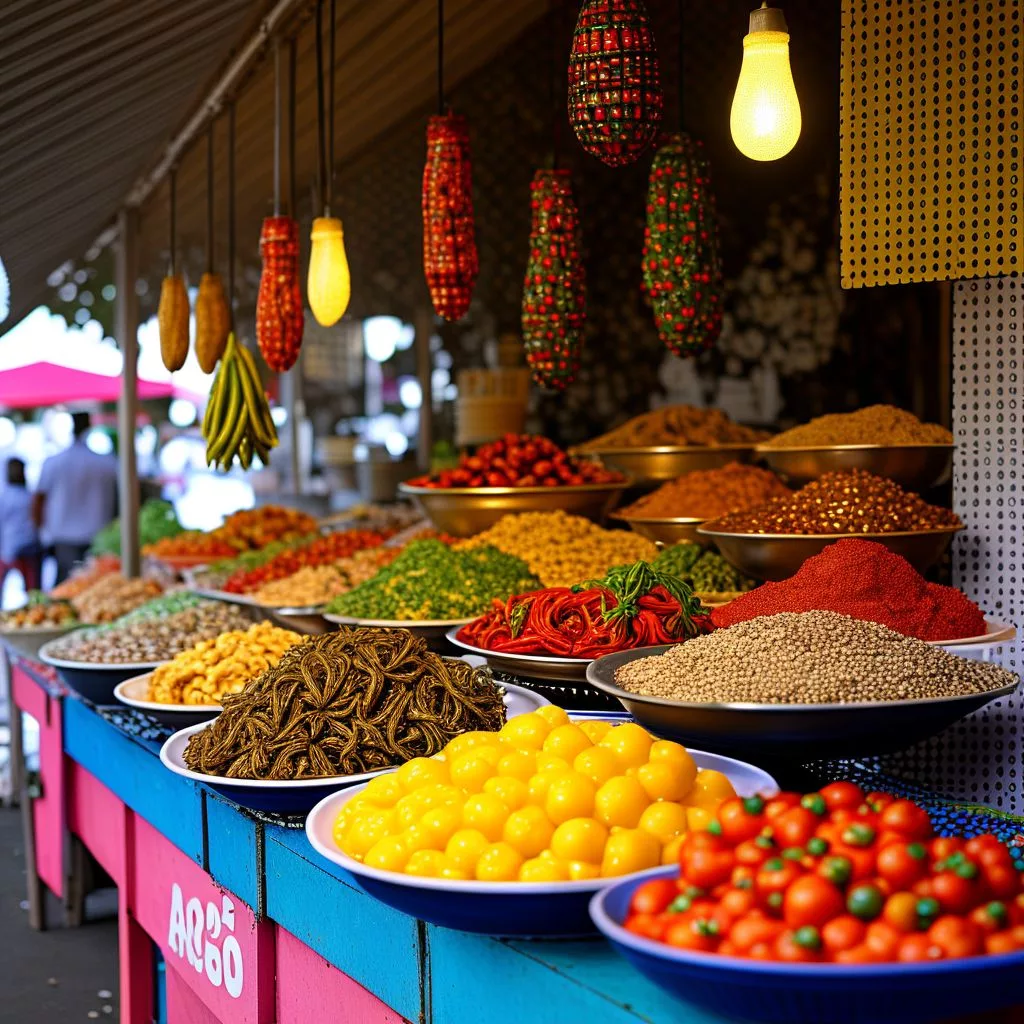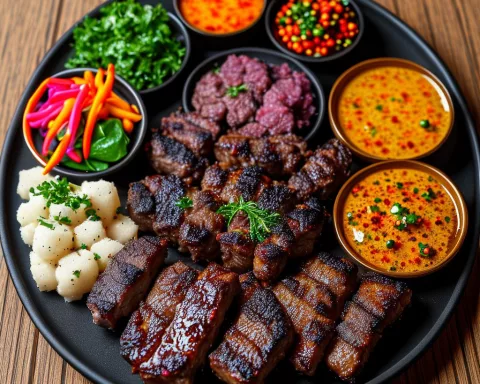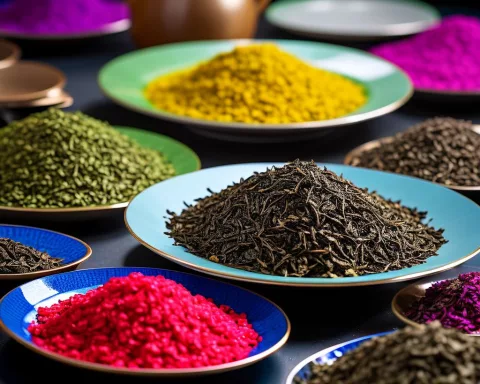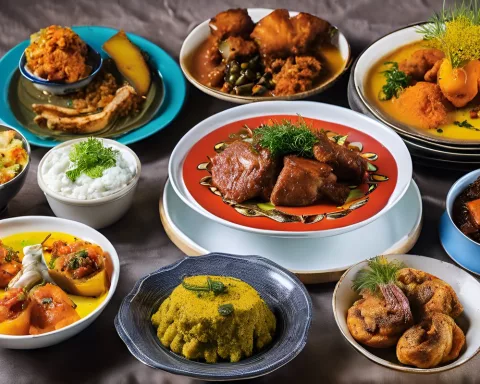South Africa is a treasure trove of unique and flavorful dishes that tell stories of its rich culture. Try “walkie talkies,” a crunchy dish made from fried chicken feet, or “smiley,” a tender sheep’s head that connects diners to rural traditions. The nutty mopane worms and hearty waterblommetjie bredie—lamb stew with water lilies—showcase the country’s creativity with ingredients. Lastly, skilpadjies, grilled minced liver wrapped in caul fat, highlight South Africa’s love for bold flavors and grilling. Each dish is a delicious journey into the heart of South African heritage, celebrating the spirit of community and sustainability.
What are some unique dishes in South Africa’s culinary heritage?
South Africa boasts diverse dishes like walkie talkies (fried chicken feet), smiley (sheep’s head), mopane worms (nutty caterpillars), waterblommetjie bredie (lamb stew with water lilies), and skilpadjies (minced liver wrapped in caul fat). Each reflects the nation’s rich cultural tapestry and sustainable cooking practices.
South Africa’s gastronomic landscape is a vibrant reflection of its diverse cultures, offering a spectrum of traditional and modern dishes that cater to all palates. While many are familiar with the sizzling allure of a braai or the aromatic richness of bobotie, the culinary treasures of South Africa extend much further. The country’s lively streets and rural kitchens offer a variety of unique dishes that not only challenge conventional tastes but also celebrate a heritage steeped in inventiveness and robust flavors.
The Allure of Walkie Talkies
Among the intriguing culinary delights is the township favorite known as “walkie talkies.” This dish, composed of fried or boiled chicken feet and heads, is seasoned with a rich blend of local spices, creating a crispy texture and a bold, meaty taste. Beyond being a gastronomic curiosity, walkie talkies are a testament to the ingenuity and resilience found in South Africa’s informal settlements and bustling food markets. In the context of global street food, they symbolize affordable indulgence, merging tradition with innovation.
Walkie talkies are not just about flavor; they embody a story of survival and creativity. In communities where resources are limited, every part of the animal is utilized, demonstrating a philosophy of resourcefulness. This approach not only minimizes waste but also highlights a deep connection to local culinary traditions that prioritize sustainability.
For those unfamiliar with such dishes, walkie talkies might initially seem unconventional. However, they offer a unique insight into South Africa’s rich cultural tapestry, where food is a medium for storytelling and heritage preservation. The dish invites food enthusiasts to explore and appreciate the diverse flavors that define South African cuisine.
Embracing the Unique: Smiley and Mopane Worms
Venture into the world of ovine cuisine, and you will encounter the uniquely named “smiley.” This dish features a sheep’s head, cooked to tender perfection by roasting or boiling, revealing a flavor profile that is rich and subtly gamey. Traditionally served with pap or bread, smiley exemplifies the nose-to-tail eating philosophy, aligning with global movements towards sustainable food practices. This dish not only tantalizes the taste buds but also provides a window into rural food traditions that emphasize the full utilization of available ingredients.
Smiley is more than just a meal; it is a cultural experience. The dish embodies the essence of South African rural life, where resourcefulness in cooking has been honed over generations. It offers a taste of history, connecting diners with age-old practices that celebrate every part of an animal, ensuring nothing goes to waste.
Turning to another distinctive delicacy, the mopane worm offers a remarkable gastronomic adventure. These caterpillars, found primarily in southern Africa, serve as a substantial protein source. Once harvested and dried, mopane worms offer a chewy texture with an earthy, nutty flavor. While some enjoy them as a crunchy snack, others prefer them cooked in a savory tomato-based sauce. Beyond their nutritional benefits, mopane worms represent a sustainable approach to food that has been practiced for generations, illustrating a profound connection to the land and its natural resources.
A Taste of Tradition: Waterblommetjie Bredie and Skilpadjies
In the Western Cape, the Afrikaner dish waterblommetjie bredie showcases the region’s fertile bounty. This stew combines waterblommetjies—small, edible water lilies—with slow-cooked lamb. These waterblommetjies, flourishing in the winter, impart a slightly tangy, earthy taste to the dish. Seasoned with aromatic spices and usually served with rice or mashed potatoes, this meal offers a comforting embrace to those who partake. It stands as a culinary emblem of Afrikaner tradition, reflecting the adaptability and perseverance of its people through the seasonal shifts of the region.
Waterblommetjie bredie is more than just a stew; it’s a culinary artifact that captures the spirit of Afrikaner heritage. It highlights the community’s ability to thrive by using locally available ingredients, transforming them into a dish that is both nourishing and culturally significant. This dish invites diners to experience the flavors of the Western Cape, providing a taste of history and tradition.
Lastly, delve into the bold flavors of skilpadjies, a dish featuring minced lamb’s liver wrapped in caul fat and grilled to achieve a crispy exterior. Inside, it remains soft and juicy, delivering an intense taste that appeals to fans of offal-based cuisine. Skilpadjies often serve as a centerpiece at braais, accompanied by pap and tomato relish. This dish celebrates the robust flavors of South African meat dishes and underscores the nation’s love for grilling and offal, elements deeply woven into its social and culinary fabric.
Celebrating South Africa’s Culinary Diversity
These five dishes not only showcase the dynamic nature of South Africa’s culinary scene but also highlight themes of sustainability, resourcefulness, and cultural heritage. Each dish offers an exploration of the interconnectedness of food, history, and identity. Whether through a resourceful township delicacy or a stew that ties communities to their seasonal rhythms, South Africa invites us to savor its complexity.
By immersing ourselves in these unique culinary experiences, we gain a deeper understanding of the nation’s soul, vividly expressed through its food. Each dish tells a story, a narrative of resilience and creativity passed down through generations. As we explore the vibrant flavors and cultural significance of these dishes, we are invited to appreciate the rich tapestry of South African cuisine—a celebration of diversity, tradition, and innovation.
“`markdown
What are some unique dishes in South Africa’s culinary heritage?
South Africa boasts diverse dishes like walkie talkies (fried chicken feet), smiley (sheep’s head), mopane worms (nutty caterpillars), waterblommetjie bredie (lamb stew with water lilies), and skilpadjies (minced liver wrapped in caul fat). Each reflects the nation’s rich cultural tapestry and sustainable cooking practices.
What are walkie talkies, and what makes them special?
Walkie talkies are a popular township dish made from fried or boiled chicken feet and heads, seasoned with a blend of local spices. They are not only a culinary curiosity but also represent resourcefulness and resilience in South African communities, where every part of the animal is utilized, minimizing waste and celebrating local traditions.
What is smiley, and how is it prepared?
Smiley is a dish featuring a sheep’s head that is cooked until tender, typically through roasting or boiling. It is often served with pap or bread and embodies the nose-to-tail eating philosophy, showcasing the importance of utilizing every part of the animal in South African culinary traditions.
What are mopane worms, and how are they enjoyed?
Mopane worms are caterpillars that serve as a significant protein source in southern Africa. After being harvested and dried, they can be enjoyed as a crunchy snack or cooked in a savory tomato-based sauce. Their earthy, nutty flavor and nutritional benefits highlight a sustainable approach to food that has been practiced for generations.
Can you describe waterblommetjie bredie and its significance?
Waterblommetjie bredie is a traditional Afrikaner stew made with waterblommetjies (edible water lilies) and slow-cooked lamb. This dish reflects the region’s seasonal bounty and highlights the adaptability of Afrikaner heritage. It is a comforting meal that captures the essence of community and local ingredients.
What are skilpadjies, and when are they typically served?
Skilpadjies are grilled minced lamb’s liver wrapped in caul fat, known for their intense flavor and juicy texture. They are often served at braais (barbecues) alongside pap and tomato relish, celebrating South Africa’s love for grilling and offal dishes, which are deeply embedded in the country’s culinary traditions.
“`












